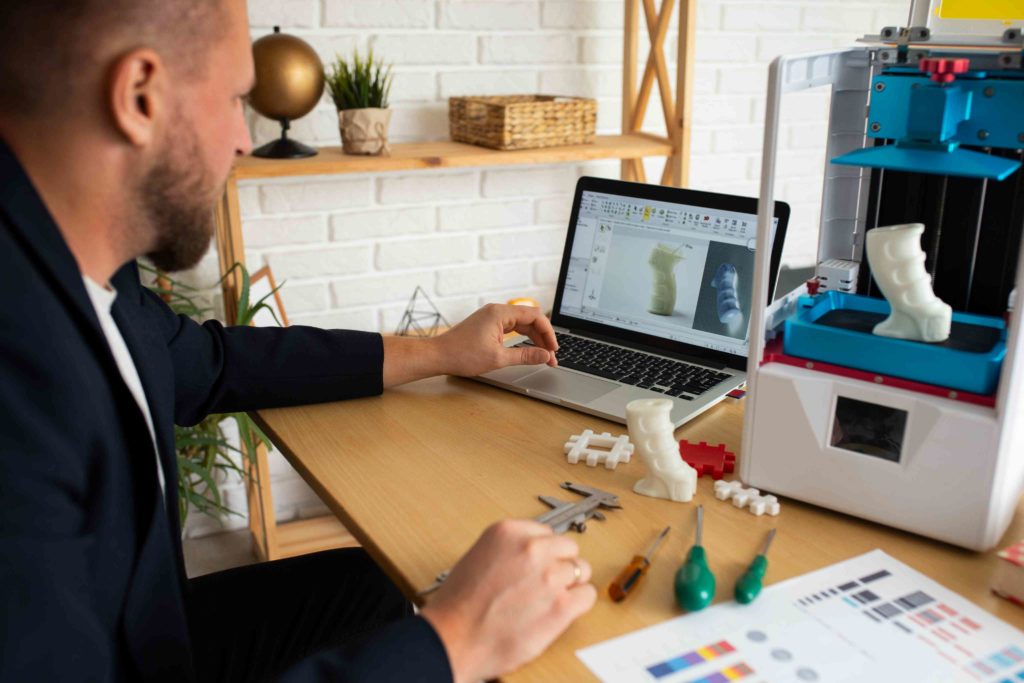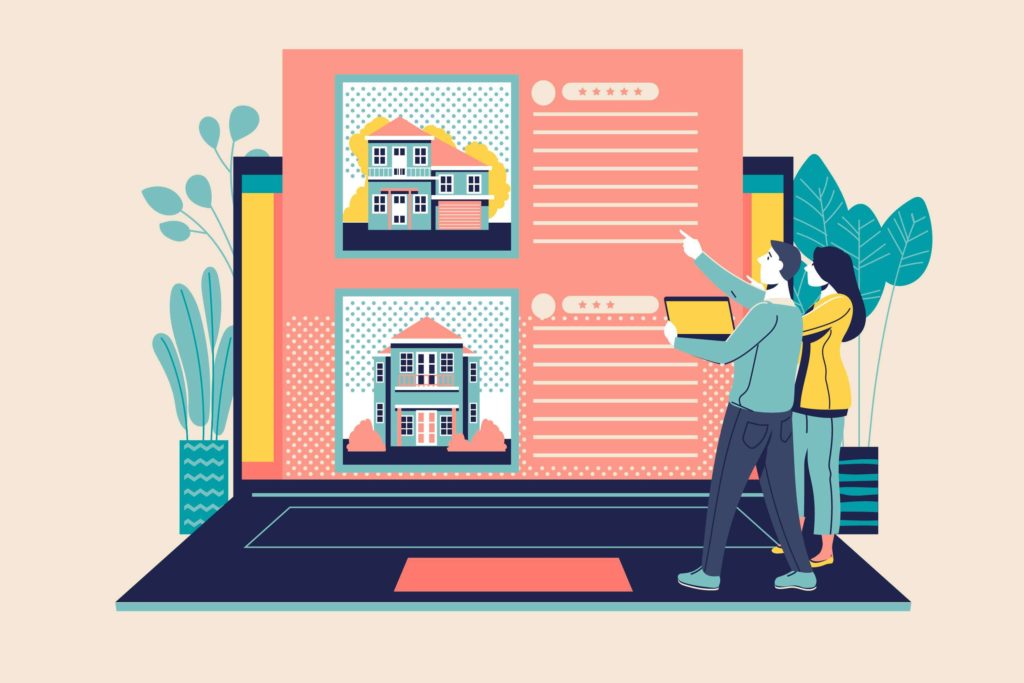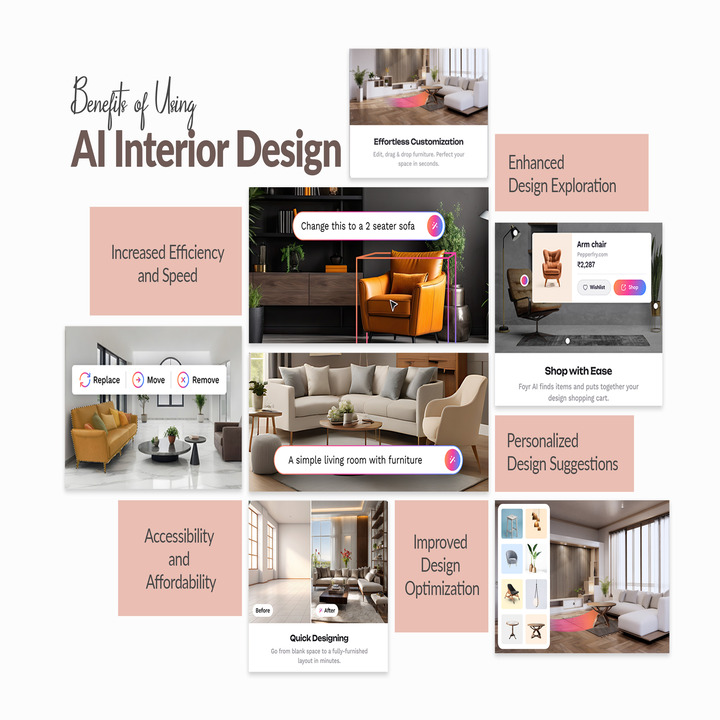Almost everyone is talking about AI these days, especially designers. Some champion the innovation, and some don’t but either way, designers are exploring one or the other artificial intelligence tools and attempting to use them in their designs. On the other hand, there’s a whole other group who want to refrain from using AI since they feel AI-generated work isn’t their original work product. Some others also feel AI is going to take their jobs very soon.
| Stacy Thorwart, Architect & Design Manager at Steelcase says, “Once you get on a community and see a lot of people are using AI, it can feel like everyone is using it. It’s easy to get freaked out and feel like you’re missing out. But, it need not be so.” |
As Stacy says, it can seem overwhelming to look at AI interior design from the outside. That’s why we’ve ai broken down the topic, analyzed it thread by thread, and given you a picture, along with our thesis, to help the decision-making process with respect to introducing or accelerating AI usage in your design business.
Benefits of Using AI Interior Design
1. Increased Efficiency and Speed

What’s one of the most time-consuming tasks apart from the most interesting creative process? Arriving at cost estimation depending on what the client’s budget is, looking for leeway, making hard choices to balance aesthetics and price, getting client approval, or restarting from scratch can be nerve-wracking in the least. It’s one of the things human designers are counted on, but it’s also something designers want to get done with as soon as possible.
You can automate all mundane and monotonous jobs and processes in your design process, especially in the initial phases. Good AI tools analyze historical datasets to project costs accurately, which is a value-add interior designers bring to the table. The power of AI does the hard, grunt work for you.
| Stacy Thorwart, Architect & Design Manager at Steelcase says, “I get asked how I launched my course, grew my Instagram page, managed my 9-5 job, and raised 2 children. It wouldn’t have been possible without AI. Using AI throughout the process has expedited things in a way I couldn’t have imagined before.” |
2. Enhanced Design Exploration

AI tools can be your guide throughout your workflow. Also, almost 47% of the field of interior design has already integrated AI technology for virtual reality modeling or showing a significant adoption rate. The demand for advanced interior design software has gone up tremendously. There’s a greater need to stand out witsiteh hyper-personalized 3D renderings that make every square foot count with exemplary design, given that space is at a premium. So, starting from the initial site visit to space planning, and deciding on layout, designers need to explore how best to maximize each square foot, which AI can ease for you if you use it to measure room automatically, ascertain furniture placement, and choose the appropriate color palettes, based on user preferences.
Once you feed historical data or train the system, it’ll start giving you designs and recommendations that align with it, so your work is almost halved. You just need to edit, supervise, and instruct it to carry out your changes. Arriving at multiple design possibilities in a given space can now be done in a few minutes, compared to hours and hours when done manually. With a new version being released every two weeks or so, you’ll be surprised to see the accuracy with which your designs are created.
No more overlapping walls, or oversized furniture in the middle of the hallway type of images. Image quality and accuracy have increased by leaps and bounds.
| Dami Lee, a senior architect from Vancouver, BC, says, “As a designer, you think conceptually first and refine the design concept throughout your design process. Without something guiding your process, it’s going to be overwhelming for you to design. |
3. Personalized Design Suggestions

Since the use of AI tools helps you pick up user preferences and deliver results that directly appeal to them, it’s way easier to choose from an ocean of design styles and decor choices and for them to make informed decisions regarding hardware, colors, material selection, finishes, etc in a short while.
Iterations take only a few minutes, so you can simply take the tool to your client meeting and as you speak to them, you can enter a prompt and show them how you visualize the space. They can point to the screen and tell you what they want done differently and you can get pre and post-modification feedback in real time.
This feedback loop is one of the most agonizing things to do as a designer – to go back and forth for weeks, and sometimes months on end until you and the client both speak the same design language and align on the decor choices. This quick, easy, and accurate way of working with AI prevents your burnout and lets the tool do all the heavy lifting, so you can tap into your creativity and design an avant-grande with the client’s personality infused into every inch of the design.
4. Accessibility and Affordability

For homeowners who can’t work with premium designers, and for beginner interior designers who need a bit of guidance when facing a tough design decision, AI can be an accessible support system. It gives homeowners a realistic idea of how their home will look like, so their expectations are realistic when they reach out to you for more detailed designs and are able to articulate their needs clearly.
For those homeowners who cannot afford to hire a premium interior designer like you, having a tool that can guide their design and building decisions shortens their search for an innovative solution. It also prevents them from making costly spends based on Pinterest suggestions without knowing what will work for their particular space.
| Gunita Kulikovska, a leading architect and designer explains, “Think of yourself as a client – you have your vision, and how you feel about a space you want to live in. What tools do you use to convey your needs to an architect? As an architect, you have your vision of how the space should be, how do you communicate it to the client exactly how you perceive it? This is where these powerful tools help.” |
5. Improved Design Optimization

Future proofing a home is essential during the conceptualization and the subsequent design phase. You need to look at the interior design project from a bird’s eye view and design items that work best now, and how to make them work better in the future, when family members increase or are likely to move out. Several things, right from the client’s current lifestyle, and timeless design trends, to socio-economic changes to plausible lifestyle changes, health status, preferences, etc, should be considered before designing each element.
Choices like the material for support grip, lighting, stairway runners, flooring for each space, energy efficiency, sustainability concerns, environmental impact, flexibility in spaces, etc are examples of those that need lifestyle factors into consideration. Predicting future needs and optimizing the design for years to come, without having the family remodel the house after 5-7 years is a great service you can do to the client and save their finances. AI will aid you in this prediction and help you effortlessly optimize your design, without leaving anything to chance.
Challenges of AI Interior Design
1. Lack of Human Creativity and Intuition

About 40% of interior design professionals hold the belief that AI will be capable of replacing human creativity by 2030. This might be far from true. It can flame your creativity, but it cannot replace your individuality, unique insights, empathy, and understanding of human emotions, and human touch. When predicting your client’s future needs, the AI tool cannot empathize and anticipate your client’s needs, and the functionality of decor materials. It can only work with the information it has been given.
This is where you can shine as the tasteful, empathizing, creative human and great designer you are.
2. Data Bias and Dependence

When many people use AI tools to create high-quality designs, every iteration of every design is saved and used to train the model to do more and better. So depending on what type of designers are using the tool you chose, the quality and accuracy of designs will vary. It entirely depends on machine learning AI algorithms and natural language processing and churns out what it is being fed. The same applies to geographical and cultural concerns as well. Based on your client’s background, preferences, and cultural orientation, you may want to modify the design deeply, if most other users created designs that don’t align with yours.
3. Technical Limitations and User Interface Complexity
Image Source: freepik.com
Some people may have difficulty using the AI tool, giving multiple detailed prompts, reengineering prompts to give what they want, and having the tool regenerate multiple images. Given how the interior design industry has recently accepted AI, it might not have all the exact designs or templates that comply with regulations in your region, or cater to your particular requirements. This can be complex for many first-time AI users.
4. Ethical Considerations and Privacy Concerns

One issue that comes with AI-generated design if not disclosed to the client is a breach of trust. Make it known to your customer that you use AI in your design process, exactly where you use it, what kind of information you feed it to get output etc. This is for the client to know where their site is and its details, or their preferences.
| Stacy Thorwart, Architect & Design Manager at Steelcase says, “A common question designers ask themselves when they contemplate using AI is if they can call the design theirs if the AI tool they use has been trained by other people’s designs. My answer to them is simple – we always take inspiration from other designers (past or present), and we refer to images on Pinterest, and other sources. This is just another source. How you edit it, and customize the design is where your genius lies.” |
This is important because, for every image you create using AI, every prompt is made publicly available. So if you’re working with a client who doesn’t want their details available to others, or if it’s a premium project and you need to keep it secret from your competitors, reevaluate your decision to use AI. Be very mindful of what you upload onto the AI tool.
When you are transparent about how you work, you instantly elevate your brand image in the eyes of the customer.
Finding the Balance: Human + AI Collaboration
| Stacy Thorwart, Architect & Design Manager at Steelcase says, “The AEC industry is complex. Bots cannot take over jobs completely. You can work hand in hand with them, just like you would with an assistant or an intern.” |
Stacy also says that the fear and uncertainty around AI might be because of a lack of the right use cases as yet. It’s fast developing and will have an ocean of use cases for you to refer to. In the meantime, starting to explore AI tools and use them to make automation possible and streamline repetitive tasks, you’ll save a lot of time and effort.
AI systems will help you translate design ideas, and concepts instantly, and is just another tool in your design toolbox. Clients aren’t going to solely rely on the tool. They need a designer to build a livable environment that’s not just pretty to look at, but also habitable for generations to come.
| Stacy Thorwart, Architect & Design Manager at Steelcase says, “When Pinterest became a huge hit, and designers began looking up Pinterest to find inspiration, there was a fear that designers may no longer be needed – but that didn’t happen. Just because you put together a Pinterest board, doesn’t mean you aren’t valuable as a designer.” |
Some of the areas where AI excels as yet are:
✅ Simplifies earlier parts of the design process (concept design, brainstorming, creative aspects, collaboration, etc)
✅ Client communication
✅ Project management, and task management
✅ Sales and marketing content for your design business
✅ Auditing your current designs for spotting and fixing errors
For any AI-powered tool to give you exactly what you need, treat it like an intern, or an assistant to whom you’d give instructions in great detail, and give constant feedback. It’s a great starting point for small design businesses to get off the ground, turn around innovative designs quickly, and get quicker results by doing less, taking on more projects, and earning more.
| Gunita Kulikovska, a leading architect and designer explains, “Designers just want to design. They don’t want to learn another complicated software. So, the AI tool has to be simple, and intuitive and should turn 3D models into virtual experiences without any extra complications.” |
Conclusion
Imagine having a capable design assistant that never sleeps and turns your wildest ideas into reality instantly. You can now skip the tedious brainstorming phase and jump straight into creating stunning visuals that sell your vision. Foyr Ideate creates space for you to focus on the creative aspects you enjoy most.
- Generate beautiful interior design concepts from simple text prompts to save hours of manual searching.
- Upload a photo of any room and completely reimagine the style or decor in seconds.
- Visualize different color palettes and materials on your existing furniture without buying a single sample.
- Produce crystal clear and professional-quality images of your generated designs to impress your potential clients.
- Generate design concepts in minutes rather than waiting days for traditional renderings or manual drawings.
Let advanced machine learning handle the heavy lifting while you focus on refining the creative details. You will be amazed at how much faster you can deliver projects and win better deals. Start your 14-day free trial of Foyr Ideate today!
FAQs
AI-powered Interior Design tools can generate multiple design options, boosting creative possibilities.
While AI can assist, it is unlikely to replace interior designers due to the need for human creativity and personal touch.
Use AI to analyze user preferences and past projects to tailor designs that fit individual tastes.
Generative AI creates multiple design iterations quickly, allowing for innovative and diverse design solutions.
Yes, by providing more accurate visualizations and customized designs based on client data.







